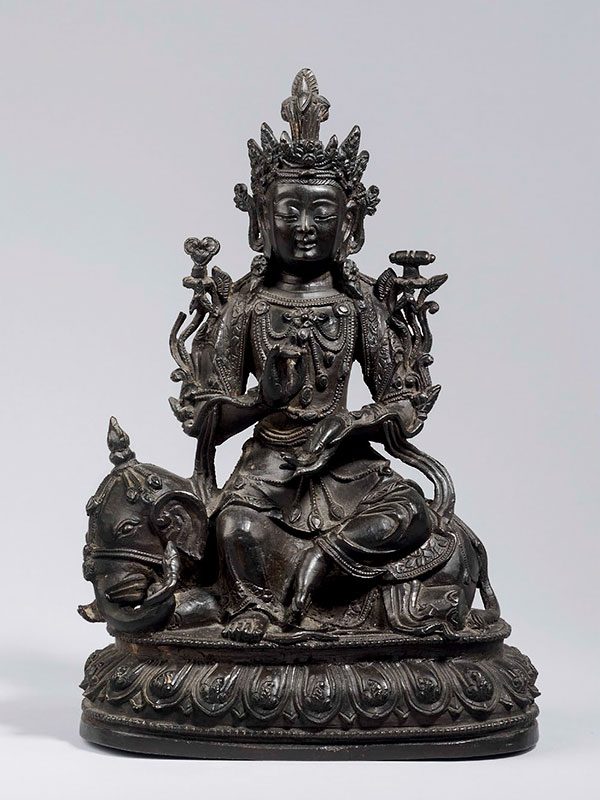Bronze figure of Samantabhadra
A bronze figure of bodhisattva Samantabhadra, seated in ‘royal ease’ (rajalilasana) on an elephant, which in turn reclines on a lotus base. The deity is dressed in layered long robes with graceful folds draped around the knees. The right arm is half-raised and the hand expresses the karana mudra, whilst the left arm is lowered in front of his waist, with palm facing upwards. An elaborate necklace with swags and pendants encircles his neck. His hair is neatly tied into a high chignon, while a pointed crown adorns his head. The elegant face has a serene, half smiling expression and is flanked by elongated earlobes, adorned with ear pendants. Two long lotus stems extending from the hands are flanked on each side of the shoulders, respectively topped with a ruyi on his right and a scroll on the left. The crouching elephant has its head turned slightly towards the left, its trunk holds a lotus bud and is curled between six tusks. The elephant wears a howdah and is richly attired with caparisons composed of ‘jewelled’ straps and tassels. The bronze is of even, dark brown colour.
Samantabhadra, known as Puxian in Chinese, is regarded as the Bodhisattva of Universal Virtue in Mahayana Buddhism – in Sanskrit, samanta means ‘universally extending’ and bhadra ‘great virtue’. Usually presented seated on a white elephant with six tusks, he is the patron of the Lotus Sutra and made the ten great vows which are the basis of a bodhisattva. The six tusks of the elephant represent the six senses that need to be overcome, as well as the six perfections or paramita of correct behaviour: charity, morality, patience, energy, meditation, and wisdom.[1] A closely comparable bronze figure of Samantabhadra seated on an elephant, slightly smaller in size and dated to the 16th – 17th century, is in the collection of the British Museum.[2] Another comparable bronze Samantabhadra, dated to the late Ming to Qing dynasty (17th – 18th century), is illustrated in The Second Bronze Age – Later Chinese Metalwork.[3]
Provenance: private collection, the Netherlands
- Welch, P. B. Chinese Art – A Guide to Motifs and Visual Imagery, Tuttle Publishing, Singapore, 2012, p. 189
- The British Museum online collection archive, museum number 1987,1007.4
- Moss, P. and Hawthorn, G. The Second Bronze Age: Later Chinese Metalwork, Sydney Moss Ltd, London, no. 7
銅鑄普賢菩薩像
明 十六 – 十七世紀
高:27公分 寬:18公分
銅鑄普賢菩薩像,自在坐於伏象背上,下托覆蓮座。普賢菩薩面龐圓潤,法相莊嚴祥和,耳璫長垂。
姿態挺拔豐健,腰身收束,身著肩搭帔帛,下披綢裙,衣褶垂襬順遂,胸前纓絡垂墜。髮束高髻,頭
戴尖頂寶冠, 頭巾繒於兩側翻卷。右手於胸前施期剋印,左手掌腹前上翻,蓮束自雙掌沿臂上伸至雙
肩處,頂端左右各托以如意與寶書。身下伏象飾以纓絡,象牙左右各三。整製工法嚴實謹練,刻鑄精
緻細膩,營造端莊寧秀之象 。通觀比例勻稱協調,時代沉雋風格別具。普賢菩薩為佛陀的右脅侍菩
薩,亦為漢傳佛教四大菩薩之一,象徵理德與德性,坐騎為六牙白象。白象象徵力大無比及「願行廣
大、功德圓滿」。倫敦大英博物館亦收藏一件造型相仿之明代銅鑄普賢菩薩像 。
來源: 荷蘭私人收藏


